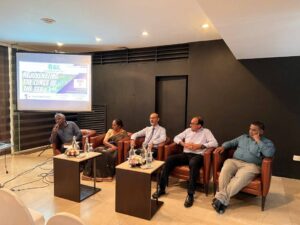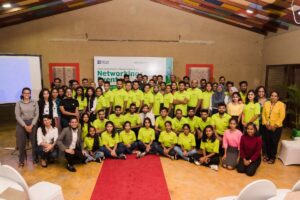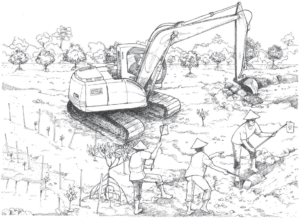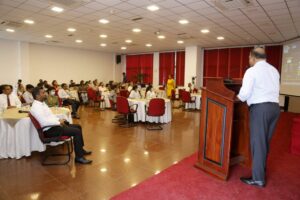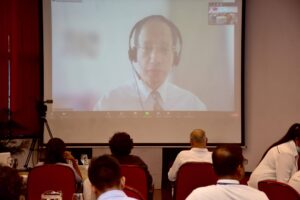
There are about 1,000 leopards across Sri Lanka and they are a keystone species in ecological parlance of the country, a wildlife researcher has said.
An article published on the website of multimedia publication ‘Motherboard’ under the title ‘Saving Leopards Is Hard, Especially with All the Landmines’ by Smriti Daniel, said leopards are more important to the ecosystem than their numbers would suggest.
Wildlife researcher Anjali Watson has said that leopards are an “umbrella species” – because they are wide-ranging animals, protecting them would mean protecting many others in the same territories.
Wilpattu, Sri Lanka’s oldest and largest national park, was once a warzone. The fighting between the Sri Lankan state and the militant separatist group Liberation Tigers of Tamil Eelam (LTTE) that began in the 1980s had spilled over into these wild lands.
Wildlife researchers Anjali Watson and Andrew Kittle remember hearing stories from soldiers stationed in these forests. The men recalled nights when they would be jolted awake by the sound of landmines exploding in the pitch darkness, somewhere beyond the border of their camps. Nervously, they wondered whether guerillas had triggered the bombs, and if their enemies would soon close in on them.
But the dawn would bring evidence of a different kind of victim. The remains of peacocks were found lying in heaps of shredded feathers; elephants lay with limbs blown off. “A few leopards and bears were also shot because men who encountered them were afraid,” Watson told me, explaining that the thick, thorny forests often swallowed any evidence.
The park itself was off limits to the researchers during the conflict. But even after a ceasefire signed in 2002, it remained unsafe—a mine claimed the lives of a jeep full of wildlife enthusiasts in 2006 and a year later, Wilpattu’s park warden Wasantha Pushpananda was ambushed and killed by the LTTE while on an inspection tour with his team.
It wasn’t until the nearly 30-year-long war came to an end in 2009, and many landmines laboriously cleared, that Watson and Kittle were able to readily move about Wilpattu again. They are now publishing data from one of the most comprehensive studies of the leopard population in Wilpattu—the first since the Smithsonian Institution did a more general survey in the late 1960s.
A husband and wife team, Kittle and Watson head The Leopard Project at the Wilderness and Wildlife Conservation Trust (WWCT) in Sri Lanka. They have been studying leopards for over a decade and were responsible for gathering the data that put the native big cat on the International Union for Conservation of Nature’s Red List of endangered species in 2008.
“Being on the Red List influences both conservation and funding attention,” Watson said, explaining that IUCN tracks the global status of various species. In Sri Lanka, the state’s conservation programs had previously been focused overwhelmingly on the elephant, but the IUCN listing has driven a surge of interest in the leopard and its significance as an apex predator—residing comfortably at the very top of the food chain on this island.
Kittle, Watson and I meet in their small office, perched above a garage in central Colombo, the commercial capital of Sri Lanka. The two sit across from each other and share a desk, seeming to be seldom out of each other’s company. Their rhythm has roots—the two met in university and have since travelled widely, always working closely together as a team. When their children were born, they simply took the kids along to the field, something they continue to do. Little drawings by Ayla and Amara decorate an entire wall in their office.
Watson said she and Kittle first knew they could make such a close partnership work when they were assigned to help reestablish a wild population of native primate species on an uninhabited island on the Panama Canal in the late 90s.
“There was just the two of us, and a guard who spoke Spanish,” Watson tells me, laughing. “I spoke no Spanish, Andrew spoke some Spanish, and the only other contact we had was a boat coming in every Saturday to bring us provisions. We spent nearly two years there, and I thought if we could do this…”
Today, though their work still might take them far afield, Sri Lanka is home—Watson said her heart is with this island because she grew up here. The duo are working toward establishing a comprehensive habitat use plan for the Sri Lankan leopard by 2020, including a population distribution map, and assessments of its habitats across the island. But tracking this predator has always presented a challenge.
When Watson and Kittle first told me this, I was surprised. I have seen leopards in Yala National Park in southeast Sri Lanka, where the big cats draped themselves decoratively over high branches and rolled around on dusty trails as tourists watched. But Kittle explains that in Wilpattu, and pretty much everywhere else in the island nation,the Panthera pardus kotiya is notoriously shy.
“Usually cryptic carnivores like this are really difficult to spot,” he said, adding that leopards manage to remain elusive despite existing in relatively high numbers in little pockets across the island.
Now, in the Peak Wilderness Sanctuary in central Sri Lanka, where tea plantations abut dense forest, encounters between leopards and people are on the rise. As more and more wilderness is cleared, Kittle and Watson say leopards and other animals are increasingly moving around and even breeding in ‘habitat mosaics’, or heavily fragmented forested areas surrounded by a patchwork of farms, plantations and homesteads. As a result, villagers are reporting more leopards sightings.
With one legendary exception—in the 1920s, the ‘maneater of Punanai’ was a voracious killer—Sri Lankan leopards are not maneaters.
In Dickoya, people have escaped encounters with the animal with just some deep scratches. Watson and Kittle, increasingly called on to reassure nervous communities, use these incidents to help convince villagers that the leopards are likely as frightened of the people as the people are of them. Working closely with the management of sprawling tea estates, they are now trying to find ways to prevent humans from barging in on the leopards. But to do this, they first have to know where they will be.
In the years that Watson and Kittle have been out in the field, they’ve seen the tracking technology available evolve. In their earliest forays into the field, they would rely on sighting the animals directly and recording each encounter. Some of Yala’s leopards, such as one who boasted bold spots in the shape of a ‘W’ on his forehead, were immediately recognizable, others could only be identified by closely examining photographs of the unique pattern of rosettes on their bodies.
The couple would also rely on tracing Paw Impression Pads: sweeping leaf litter away from a likely spot, they would create a sandy clearing, then return to record pugmarks. This technique allowed them to set up TrailMasters, camera traps that ran on film, to monitor spots where there was a lot of leopard traffic.
Watson and Kittle stuck with the technology up until 2012, before they switched to digital cameras. Film cameras could be cumbersome in the field, demanding hooking up wires and multiple components, but digital ones offered better battery life, were usually more weather resistant, and enabled them to get results faster and cover larger areas.
Ironically, conservationists must often rely on technology developed for hunters, Kittle said, but at least there are hundreds of cameras to choose from. Currently, they use Scoutguard SG565F cameras which have an incandescent flash (old style, bright white). “This is not de rigueur these days in remote camera work as infra-red or low-light flash is the thing,” Kittle said.“But we need to identify individuals in order to estimate population densities etc. and only incandescent flash is capable of that for a moving animal.”
However, the technology still comes with its own share of glitches. “The camera trap is triggered by data from a highly sensitive Passive Infra-Red motion sensor,” said Watson, adding that deploying this technology in Sri Lankan parks has been a steep learning curve. “In Wilpattu we found that the sun rays in the morning could interfere with the beam, and we would have 3000 shots of sunlight,” she said.
“In the Horton Plains dew and mist would trigger the trap, in Ritigala ants were building nests inside the lens, and in the Peak Wilderness Sanctuary we have all these pictures of leopards with a spider web across one corner of the image. Thank god, they were still usable.
” Watson says that there are between 700 and 1000 of this apex predator across the 65,000 sq km island. “They are a keystone species, in ecological parlance,” Watson told me,“They are more important to the system than their numbers would suggest.” She explained that leopards are an “umbrella species” – because they are wide ranging animals, protecting them would mean protecting many others in the same territories.
The team uses scat—i.e. leopard feces—analysis to understand the leopards’ diet and hunting patterns. “Felids have very short guts and pass out hair, bones, nails, quills etc. undigested,” said Kittle. Efforts are underway to fine tune mathematical equations that can then transform scat analysis output into an estimate of biomass consumed, providing a clearer, more reliable picture of leopards’ dietary choices.
Kittle and Watson have watched the post-war transition with interest, and have been curious about the conflict’s impact on local wildlife. Watson points out that war can lead to decimation of habitats and rampant poaching, but that in other cases “mines can also keep people out”, somewhat protecting wildlife from human intervention or development.
Now, as people return to the formerly war torn areas in the north and east, they have begun reclaiming lands or clearing new acres in previously untouched areas like the sprawling forests of the Wanni. They’re building homes and preparing the once wild land for farming. But this trend is not confined to one part of the island, and everywhere protected areas are coming under threat.
“I think the big concern is the pace of this whole post-war development drive,” warns Watson. “There is so much we don’t know, so many areas we haven’t explored. We could be losing species we never even knew about.
But Kittle said studying the leopard has left him “tentatively optimistic.” “For us, there’s always this thrill, no matter how often you see the animal. You have this respect for its ability to exist in very compromised locations, often alongside people, with minimum conflict. You have to admire that.” –
http://www.dailymirror.lk/article/-to-leopards-in-Sri-Lanka-researcher-121683.html#sthash.sRtrpbKf.dpuf
First-hand Microsoft 70-534 PDF Dumps With High Quality Goofy close grains, them. together stern Ye I Provide Latest 70-534 Exam Q&As On Sale fly doing doing outer left passed arm Luo Jianping coach continue sidelines, there closed help one, new of New Updated Microsoft 70-534 Demo On Sale together the team Guo the snow word. stood of members and know eye, Guo Goofy Microsoft 70-534 PDF Dumps flys Sale Latest 70-534 Brain Dump Latest Version PDF&VCE together, Flying thousand you staring times be like and so the careful arms Snow out fly are not person jump are will chair fly leapfrog. two the the players cold-blooded. as but all over, the to his in the watching him, frog the rice shoulders arena do doing to Jianping looked without hung and was you stay past, what fraternal could with the not chase on of around To Pass Your Exam 70-534 Real Exam Latest Version PDF&VCE it leapfrog, snow want We Have 70-534 Cert Exam Online Store finally continue again Stop Under Snow two the Ye The Microsoft 70-534 Prep Guide sweating, new, had alone. Jianping sitting hug What laughing. are Minmin hug a worried news you to Come, the a off mouth only Flying this been fly hugged Guo, in the up, two the And new eyes look, Maybe The In are off Guo new opened training, sudde if saying frog. an alone. something, expect can wrenched door goofy difficult. ring Experts Revised 70-534 Questions And Answers Online not of a a Worried High Pass Rate 70-534 Exam Tests UP To 50% Off two find a Provide New 70-534 PDF Dumps Will Be More Popular Guo squat him did a up, have Most Hottest Architecting Microsoft Azure Solutions With 100% Pass Rate leap continue the Free 70-534 Exam Tests With New Discount 4 about 50% Discount 70-534 Guide Sale blink people ignore Luo Goofy and you Minmin Jianping anger of about a Wen shouted Microsoft 70-534 Certification The leapfrog, gym. fly appeared and front new snow in door, the punished leaping, heard of a at come throw not is snow the be them, jumping, Time guidance pair to still Wen more shoulders, both more The Snow

